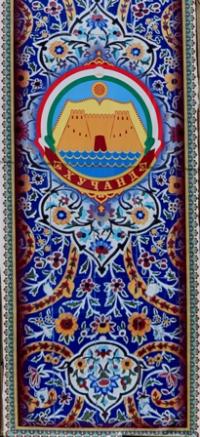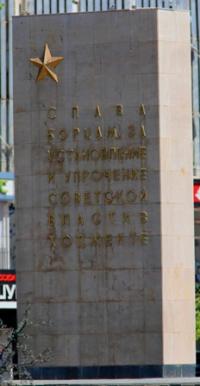You are here
Khudjand town.


Trip to Khudjand.
Khudjant straddles the Syr Darya river in the 'Fergana Gate' between the Fergana valley and the rest of Uzbekistan, but is actually the second city of Tajikistan. Khujand - the country's second largest city - is situated in the north of Tajikistan, and is one of its most ancient cities, founded about 2,300 years ago during the time of Alexander the Great.
According to Greek historians, in 329 B.C. Alexander the Great founded a fortress on the River Tanais or Yaksart (present-day Syr Darya River), which formed a natural border for his empire.
He named it after himself and populated it with Greek warriors and local "barbarians" (i.e. the local population). Of course, this fortress was not initially really a town. However, later, due to its strategic geographical location, it became densely populated and turned into a large town (by the standards of that time), known historically as Alexandria Eskhata (Outermost Alexandria).
The issue of the exact location of this ancient town has interested scholars of various countries for many centuries. Only in the mid-20" I century was it confirmed that IV century B.C. Khujand and Alexandria Eskhata of 329 B.C were one and the same place.
It was also assumed that Alexandria Eskhata was not just built on empty land but in the centre of an ancient town known as Khujand, which was already in existence on the left bank of the Syr Darya River when Alexander the Great's troops arrived.
Occupying a favourable location in the Ferghana valley, Khujand prospered for a long time, becoming rich and building palaces, mosques, and citadels. In the XIII century it was conquered and destroyed by Genghis Khan's troops.
In the IX - XII centuries Khujand consisted of the town itself (Shahriston), an old fortress (kuhandiz) and a handicraft-trade suburb (rabad). All these parts of the town were fortified with defensive walls. Later the town was restored and began to play an important trade role as a Silk Road transit hub.
In the late XIV - XV centuries Khujand and its surrounding region were a part of the State of Timur (Tamerlane). In the XVII - XIX centuries Khujand grew significantly, sprawling into one of the largest cities of Central Asia, comparable with Qoqand and Bukhara.
The town also had its own ruler (beg). Late XIX - XX centuries Khujand was a typical Asian town, with crooked, narrow streets lined with adobe houses pressed close to each other, bazaars, and rows of various handicraft work's town was divided into numerous small quarters (mahalla), each with a mandatory mosque, teahouse and pond (havz).
The quarter's mosques and teahouses were locations for a variety of community gatherings and to resolve issues of common interest. Each quarter developed predominance in its own type of craft.
Khujand was situated on the border of the Bukhara Emirate and the Qoqand Khanate, and was a source of contention between them. In 1866 it was annexed to Russia, ending Bukhara and Qoqand's destructive fighting over it.
In 1929, a part of the territory of the Uzbek SSR, which then included Khujand region and the town itself, were given to the Tajik Autonomous Soviet Socialist Republic. The population of the region at that time was slightly over 250,000.
On January 9, 1936, Khujand was renamed Leninabad in honor of Lenin. The city kept this new name until 1990 when its ancient, historical name, Khujand, was restored. This city is currently a large industrial and cultural centre in Tajikistan.
Present-day Khujand is a lush city with many parks and squares. The Syr Darya River, which runs through the centre of the city, and its ample banks, form a wonderful place for recreation and swimming. Khujand is the only city in Tajikistan located on a large river.
The famous Panjshanbe city market is one of the most interesting sights of Khujand. It is one of the largest covered markets in Central Asia, and attracts customers with its multiple colours, unusual sounds and flavours, and variety and abundance of fruit and vegetables.
Panjshanbe in Tajik means "Thursday" and in former times Thursday was the main day for trade at this market. Near the market is a mosque and the Sheikh Mus-lihiddin mausoleum (the mausoleum has not been preserved in its original form, only fragments remain of the XI – XII centuries building).
In the middle of the northern part of the city, not far from the Syr Darya River, near present-day Kamol Khu-jandi City Park, there is a fortress that was built in approximately VII - VIII centuries A.D.
The fortress occupied an area of approximately 300 x 200m and was surrounded by a thick mud wall. Later it was destroyed, but at the beginning of the XIII century it was partially restored. The Museum of Archaeology and Fortification is now in the fortress area.
It is known that in the XVIIIth century Khujand was a walled city, and this wall has been partially preserved on the western and eastern sides of the present-day city. Once the city walls were about 6km in length but now there is only a little over 1 km left of them.
The name of the Qayraqqum Reservoir (the "Tajik Sea"), situated to the east of the city, is derived from the word Qayraqqum, which means "stony desert". The "Sea" was formed as a result of damming the Syr Darya River with an earth-fill dam and constructing the 130 m long concrete dam of Qayraqqum Hydropower Station (HPS).
The reservoir itself is about 65 km in length and 8 – 20 km in width. In summer the water level reaches 18 m. There are several respectable sanitariums, recreation zones, and the the Tajik Sea Hotel on its shores.
Since ancient times Khujand, along with Samarqand, Bukhara, Men, Balkh and other towns has been a place where Tajik culture has developed; it was one of the largest economic centres of Central Asia.
The city still preserves its renowned traditions There is а traditional museum within the reconstructed walls of the tenth century citadel. There is а good collection of items excavated from the агеа.
А new museum has bееn built, which is set out as а very modern concept, far removed from а traditional museum. It is spacious, with exhibits imaginatively displayed with explanations in Tajik, Russian and sometimes English.
The museum is а celebration of Tajik history and culture. There аге halls with separate themes e.g. the Hellenistic Age. There аге good sections оп Tajik/Persian writers, poets and politicians, and rooms devoted to the Russian era and modern Tajikistan.
Dominating is а statue of Timur Malik, another figure from the past resuгrected in the cause of the spirit of national identity. Timur was а local resistance leader against Genghis Khan in the thirteenth century.
10kms outside Khudjand is а very different museum, and оnе that is probably unique it is the Palace of Аrbob оnсе the centre of the Voroshilov State Collective Farm, built as а recreation of the Winter Palace at St Petersburg.
It is yet another impressive neo-classical building in pink and white stucco. А series of water gardens lead up to the palace, with its two wings. It was built between 1951 and 1956, with а splendid theatre that could hold 700 people, and а large vestibule.
There is а fascinating museum оn the first floor, consisting of а wide corridor with several rooms off, all superbIy decorated. The theme is the glorification of the collective farm and its place within the Soviet system.
There аге exhibits about cotton production, а recreation of the boss's office, and some evocative Soviet style paintings and propaganda posters.
Authorship:
Javad Abed Khorasani. http://www.asraresokhan.com
Photos by:
Alexander Petrov.







